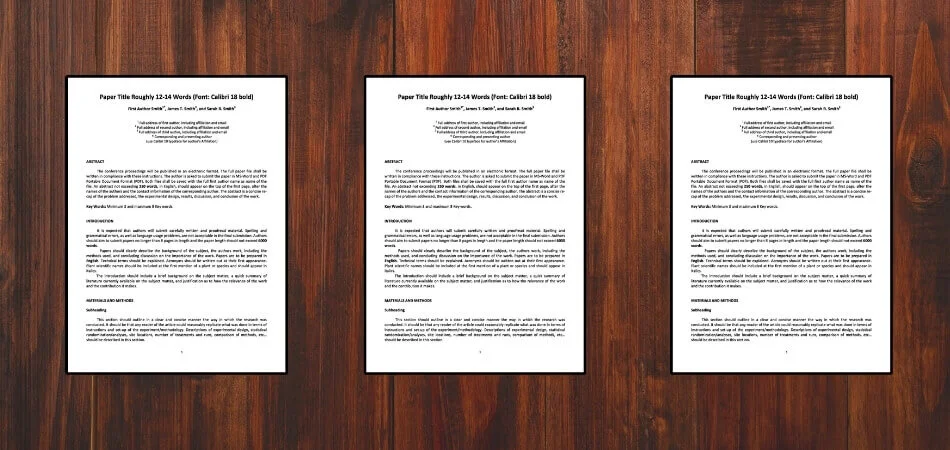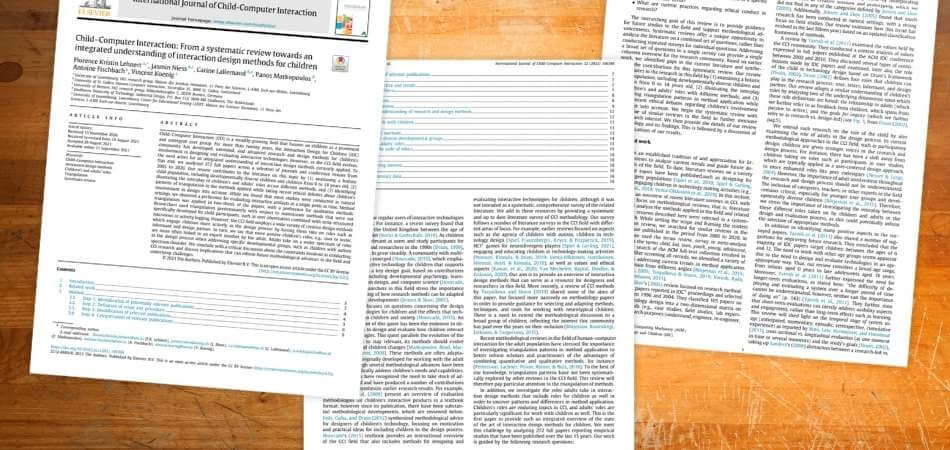Conference papers are a common requirement for academic and professional events, giving researchers and students a chance to share their work with a wider audience. For many first-time presenters, the real question is simple: what should a conference paper contain?
A strong paper usually follows a clear structure that includes an introduction, background or literature review, methods, results, discussion, and conclusion. Each section serves a purpose, from setting the context to explaining findings and showing why they matter. Together, these parts create a complete and credible piece of work.
Preparing a conference paper doesn’t have to feel overwhelming. This guide will walk you through what to include in each section and show you how to present your ideas in a clear and professional way that resonates with your audience.
What Should a Conference Paper Contain?
Writing a conference paper is about presenting your work in a clear and well-structured way. A simple conference paper definition is that it’s a document created to showcase your research at an academic or professional event. Each section has its own role in telling the full story of your study. Let’s look at the parts every strong conference paper should include. Here are the key components of a conference paper.
Quick Checklist
The conference paper structure is built around key sections, each serving its own purpose in telling the complete story of your research. Here are the essential conference paper sections you’ll need to include for a complete and professional submission
- Title and Author Details
- Abstract
- Keywords
- Introduction
- Methodology
- Results
- Discussion
- Conclusion and Future Directions
- Acknowledgments
- References
- Optional Sections (ethics approval, data availability, conflict of interest)
Title and Author Information
Your title should be short, specific, and reflect the main theme of your work. Add your full name, affiliation, and contact details. If there are multiple authors, list them in the correct order with their institutional details for proper acknowledgment.
Abstract
The abstract is often the first part readers check, so it needs to be written carefully. In about 150–250 words, summarize the purpose of your study, the methods used, the main results, and why it matters. A well-written abstract makes your conference paper for attending international conference or even a local conference stand out and grab attention right away.
Here are two practical abstract templates, one structured and one unstructured.
Unstructured Abstract Example:
[Background/Context]
Briefly introduce the problem or issue your research addresses and why it matters.
[Objective/Purpose]
State the main goal of your study or the research question you set out to answer.
[Methods]
Summarize the methods or approach you used. Keep it short and simple.
[Results]
Highlight the main findings of your study. Mention key data points if possible.
[Conclusion/Significance]
State what the results mean, why they are important, and how they contribute to the field.
Structured Abstract Template:
[Background]
Provide a short statement of the research problem or context.
[Objective]
Clearly state the aim or research question of your study.
[Methods]
Briefly describe the study design, materials, participants, and analysis approach.
[Results]
Summarize the key findings. Use numbers or percentages where relevant.
[Conclusion]
Explain the main takeaway, significance, or implications of your study.
Keywords
After the abstract, provide four to six keywords that represent the central themes of your research. Keywords make your work easier to find in databases and conference proceedings, so choose terms that are accurate and commonly used in your field.
Introduction
The introduction sets the stage by explaining the background of your study, what gap you are addressing, and the main research question or objective. This section should catch the reader’s interest and make them want to know more about your work.
Methodology
The methodology explains how you carried out your research. Describe your approach, the data collection process, and the analysis methods in a way that others can follow or replicate. A clear methodology adds credibility and shows your work is well-grounded.
Results
In this section, present the findings of your study in a direct and logical manner. Use visuals like tables, figures, or graphs to make complex data easier to understand. Focus on facts here, avoid mixing results with interpretation.
Discussion
The discussion interprets your findings and connects them to the bigger picture. Explain what your results mean, how they compare to previous studies, and why they matter. Also, point out any limitations so readers understand the scope of your research.
Conclusion and Future Directions
Wrap up your paper by summarizing the most important findings and their implications. Highlight the contribution your work makes to the field. Suggest possible areas for future research to show that your work opens the door for further exploration.
Acknowledgments
Use this space to thank individuals, institutions, or organizations that helped with your research. Whether it’s funding, technical assistance, or guidance, giving proper credit adds professionalism and transparency to your work.
References
End your paper with a complete list of the sources you used. Follow the citation style required by the conference, such as APA, IEEE, or MLA. Whether you call it a conference article or a paper, accurate references show respect for previous work and strengthen your credibility.
Optional Sections
Depending on the conference, you may also need to add sections like ethics approval, conflict of interest declarations, or data availability statements. These are increasingly common and highlight responsible research practices.
Simple Template You Can Use
Here’s a quick structure you can follow when writing your paper:
Title of the Paper
Author(s), Affiliation(s), Contact
Abstract (150–250 words)
Keywords (4–6)
- Introduction
- Methodology
- Results
- Discussion
- Conclusion
- Acknowledgments
- References
A good conference paper is more than a collection of sections; it’s a complete story of your research told in a clear, structured way. By including all of these elements thoughtfully, you’ll create a paper that is easy to follow, valuable to readers, and memorable to your audience.
Significance of the Conference Paper
Conference papers play an important role in both academic and professional life. They provide more than just an opportunity to present research or ideas; they create real chances to grow and connect with others. The impact of conference papers is most visible in the practical benefits they bring, from sharing knowledge to building recognition. Let’s look at the key benefits in detail.
Knowledge sharing
A conference paper allows you to present your findings, insights, or new ideas to an audience that values them. This exchange of knowledge often sparks meaningful discussions and can even inspire further research or projects that build on your work.
Networking opportunities
Presenting a paper naturally draws attention from peers, mentors, and industry experts. These interactions can lead to collaborations, constructive feedback, and long-term professional connections that continue to support your growth beyond the event itself.
Professional recognition
Having your work accepted at a conference signals credibility. It highlights your role as someone contributing actively to your field, which can strengthen your reputation, open new doors, and create a sense of achievement in your academic or professional career.
In short, the significance of a conference paper lies in the way it brings together learning, relationships, and recognition, all of which help you move forward in your field.
Discipline-specific Structures
Not every field follows the same writing style when it comes to conference papers. The structure often depends on the discipline and the expectations of that academic community. Knowing these differences will help you shape your paper in a way that feels right for your field. Keep reading to see how different areas approach paper writing.
Comparison Table
| Discipline | Common Structure | Key Features |
| STEM (Science, Technology, Engineering, Medicine) | IMRaD – Introduction, Methods, Results, and Discussion | Highly structured, focuses on replicability, clear data presentation, and concise conclusions. Often includes visuals like graphs and tables. |
| Computer Science (LNCS/ACM style) | Title, Abstract, Keywords, Introduction, Related Work, Methods, Results, Discussion, Conclusion | Strong emphasis on literature review and related work; follows strict publisher templates (LNCS or ACM). Formatting rules are very detailed and must be followed closely. |
| Humanities | Argument-driven (Thesis, Evidence, Conclusion) | Less rigid structure, focuses on building arguments and interpretations. Relies on narrative style, citations, and critical discussion rather than data or experiments. |
Each discipline values clarity but in slightly different ways. By understanding these structures, you can prepare a paper that feels natural in your field and meets reviewer expectations. Use this as a guide to match your work to the right style.
How to Write a Conference Paper Properly?
Writing a paper for a conference works best when you treat it as a step-by-step process. Each stage has its own role, and skipping even one can make the final draft weaker. If you’re wondering how to write a conference paper step by step, following a clear process will make the task easier and less stressful.
Understand the Call for Papers (CFP) and Theme
Read the conference guidelines carefully, noting the theme, deadlines, word count, and formatting rules. Overlooking these can get your paper rejected before it’s reviewed.
-
- Do: Highlight key instructions in the CFP.
- Don’t: Assume all conferences follow the same rules.
Pick a Relevant Topic
Select a topic that matches the theme and also interests you. A well-chosen topic adds value to the event and makes writing more enjoyable.
-
- Do: Ask yourself if your topic connects directly to the conference theme.
- Don’t: Pick something too broad or unrelated just because it’s easier.
Do Research and Literature Review
Study existing work in your field and identify gaps where your contribution fits. This helps you avoid repeating what others have already done.
-
- Do: Use recent studies and credible sources.
- Don’t: Rely on outdated or irrelevant references.
Create a Clear Outline
An outline works like a map, keeping your ideas structured and avoiding last-minute confusion. It shows how each section connects.
-
- Do: Break your paper into introduction, methodology, results, and conclusion.
- Don’t: Start writing without a plan—you’ll waste time reorganizing later.
Draft Each Section
Focus on clarity and flow while writing. Don’t aim for perfection in the first draft; getting your ideas down is the main goal at this stage.
-
-
- Do: Write in simple, straightforward sentences.
- Don’t: Over-edit while drafting—it slows you down and breaks focus.
-
Revise and Edit According to Guidelines
Editing is where your paper really takes shape. Check clarity, grammar, and flow, and compare your draft against the official instructions again.
-
- Do: Double-check word counts, headings, and reference style.
- Don’t: Submit without proofreading—small errors can create a poor impression.
Following this process step by step makes conference paper writing much less stressful. Keep the do’s and don’ts in mind, and you’ll end up with a paper that is polished, professional, and ready for submission.
Conference Paper Writing Considerations
Even with strong research, the way you prepare your paper can make a big difference in how it’s received. A few thoughtful choices in style, structure, and presentation go a long way toward making your work stand out. Here are some key points to keep in mind when writing.
Align with Themes
Make sure your paper matches the conference’s theme and objectives. A well-aligned paper shows that you’ve paid attention to the call for papers and increases the chance of acceptance. Always connect your work to the central focus of the event.
Clarity and Concise
Every word in your paper should add value. Since conference papers are usually shorter than journal articles, the standard length of a short conference paper is often around four to six pages, so keeping your writing clear and straight to the point matters. Avoid unnecessary jargon, and aim for simple sentences that anyone in your field can follow.
Methodological Rigor
Your methods must be easy to understand and strong enough to inspire confidence. Be transparent about how you collected and analyzed your data. A rigorous approach doesn’t need to be long; it just needs to be clear, logical, and reproducible.
Engaging Data Presentation
Numbers and results carry more weight when presented well. Use tables, graphs, and charts to highlight key findings. Keep visuals simple and easy to interpret, ensuring they support your arguments instead of overwhelming the reader.
Critical Analysis
Don’t stop at presenting results; explain what they mean. Discuss how your findings fit into the bigger picture of your field, note any limitations, and suggest areas for further work. A thoughtful analysis shows depth and makes your paper more memorable.
These considerations may seem simple, but they are often what set apart an average paper from a strong one. Keep them in mind as you write, and your work will have a better chance of making a lasting impact.
Common Mistakes to Avoid
Even strong research can lose its value if the paper includes avoidable mistakes. These issues often appear small but can reduce clarity, impact, and even acceptance. Knowing what to watch out for will help keep your paper professional and well-received.
Key Mistakes
- Abstract Too Vague: An abstract that doesn’t clearly explain the purpose, methods, and main results fails to spark interest. Readers and reviewers want to quickly understand your study’s importance. A weak abstract can make them skip your work altogether.
- Results and Discussion Blurred: When findings are mixed with interpretations, the reader can’t separate what was discovered from what it means. Keeping results factual and discussion analytical ensures your paper is easier to follow and more impactful.
- Missing Keywords or Disclosures: Forgetting to add keywords limits your paper’s visibility in databases and search tools. Skipping disclosures, such as funding or conflicts of interest, raises questions about credibility and may weaken trust in your research.
- Not Following the Conference Template – Every conference provides strict formatting instructions for a reason. Ignoring them makes your paper look careless and can lead to automatic rejection. Following the template shows professionalism and respect for conference rules.
By avoiding these mistakes, you make your paper clearer, stronger, and more professional. Think of this list as a quick checkpoint before submission; it can save your research from being overlooked for reasons unrelated to its quality.
Frequently Asked Questions
After learning about the structure and process of writing a conference paper, it’s natural to still have a few doubts. Many researchers often wonder about practical details that aren’t always covered in the main guide. Below are some of the most common questions you might have—and clear answers to them.
Can I Submit the Same Paper to Multiple Conferences?
Most conferences expect original submissions and do not allow duplicate papers. Submitting the same work to different conferences at once could lead to rejection. Always check each conference’s policy before making a decision.
Do Conference Papers Get Published Online?
Yes, many conferences publish accepted papers in digital proceedings or indexed databases. This makes your research accessible to a wider audience even after the event. Always confirm if the conference includes publication in its package.
How Early Should I Start Writing My Paper?
It’s best to start drafting at least two to three months before the submission deadline. This gives you enough time for research, writing, and proper editing. Rushing often results in careless mistakes.
Can I Include Co-authors in My Conference Paper?
Yes, you can include co-authors who contributed significantly to the research. Their names, affiliations, and contact details should be clearly listed on the title page. Proper acknowledgment of all contributors is both professional and ethical.
Do I Need to Pay a Fee to Present My Paper?
Most conferences charge a registration fee for accepted papers. The amount can vary depending on whether the event is local, international, or hybrid. Always review the registration guidelines to avoid last-minute surprises.
What Happens If My Paper Gets Rejected?
Rejection is common and not the end of the road. You can use reviewer feedback to improve your work and submit it to another conference. Many researchers face rejection before eventual acceptance.
Should I Prepare Slides Along With My Paper?
Yes, if your paper is accepted, you’ll often be asked to present it. Preparing slides helps communicate your findings more clearly to the audience. Keep them simple, visual, and aligned with your paper.
Concluding Words
A strong conference paper is more than just a requirement—it’s an opportunity to share your research in a way that others can connect with and learn from. When written clearly, it leaves a lasting impression on both reviewers and peers.
The answer to What Should a Conference Paper Contain lies in organizing your work into clear sections that explain the problem, methods, findings, and insights. Each part plays an important role in guiding the reader through your research.
By keeping your writing simple, structured, and focused, you give your paper the best chance to be accepted and appreciated. A well-prepared paper not only builds your academic profile but also contributes meaningfully to your field.









